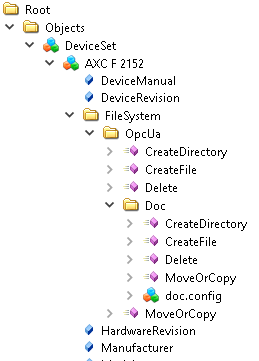OPC UA® file access
Tutorial video
Note: Tutorial videos are embedded from the Phoenix Contact Technical Support YouTube channel. With playing an embedded YouTube video in this platform, you accept the YouTube Terms & Conditions. Even showing the video previews on this page depends on your personal settings. To watch YouTube videos, you have to allow cookies for marketing purposes which will remain on your device. The data gained through these cookies will be used by YouTube to provide video suggestions and advertisements based on your browsing habits, and that data may be made available to other parties.
| 04m:11s | HDTV 720p | English | English |
How to
All directories and files are displayed in the http://phoenixcontact.com/OpcUA/Files/ namespace in a tree structure. Via the GlobalDataSpace namespace, the corresponding NamespaceIndex can be determined from the NamespaceArray. The NamespaceIndex is a numeric value for identification of the namespace. It is saved in the NamespaceArray. Via the NamespaceIndex and the NodeIdentifier, the released data and directories can be retrieved.
The initial entry point for released directories and files is the FileSystem folder of type FolderType. In this folder, released files and directories are displayed in a tree structure, starting with the symbolic folder indicated in the config file:

The nodes are not stored recursively in order to save system resources. This means that not all nodes are loaded directly upon startup. The next level is only loaded once the OPC UA® client opens a node.
File access must be configured and enabled in PLCnext Engineer.
The NodeIdentifier is structured as follows: [Symbolic name]|[directory name]/[file name]
Example: OpcUa|OpcUa/Doc/doc.config
